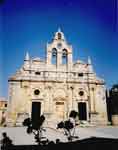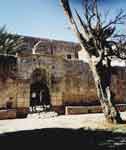.
Moni Arkadiou (Arkadi Monastery) is a 16th century monastery located 23km south-east of Rethymno on the island of Crete.
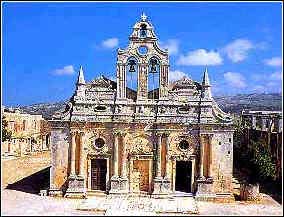
Information from http://stigmes.gr :
The Arkadi Monastery is one of Crete's most venerated symbols of freedom. The defiant defence of this fortress-like monastery during the 1866 Cretan rebellion against the Turks is still legendary and inspirational.
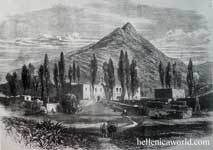
By the mid-1800's, the Turks had occupied Crete for more than two centuries, despite frequent bloody uprisings by Cretan rebels determined to win independence and union with Greece. Then came the revolution of 1866, instigated by a 16 member revolutionary committee. Arkadi Monastery became the rebels' headquarters, owing to its central position on the island and strategic location atop a craggy inland gorge.
When the Turkish Pasha in Rethymnon learned of the rebels operating out of the monastery, he sent an ultimatum to Arkadi's Abbot Gabriel Marinakis: either expel the revolutionary committee or the monastery would be destroyed.
But Abbot Gabriel was himself acting as chairman of the committee. He refused the Pasha's demand. The rebels began preparing the monastery for the anticipated Turkish attack. At dawn on November 8, 1866, the Arkadi defenders awoke to find the monastery surrounded by 15,000 Turkish soldiers armed with 30 cannons. The monastery walls were manned by only 259 armed men, including 45 monks and 12 of the 16 revolutionary committee members. There were also almost 700 unarmed women and children from nearby villages, seeking refuge from the encroaching Turks.
The Turkish commander's demand for surrender was answered by gunfire. The battle was on.
Turkish troops stormed the monastery gate in waves and hundreds were mown down by heavy fire from the defenders and from seven Cretan snipers who had barricaded themselves in a windmill outside the walls. As night fell on the first day of the battle, the fields around the monastery were heaped with Turkish corpses. The snipers had died one by one. But still the gate and walls held.
In the dark of the first night, the two Cretan rebels were lowered by a rope from a window, dressed as Turks, to slip through enemy lines and seek reinforcements from a nearby town. When it was learned that no help was coming, one of the rebels crept back through Turkish ranks to return to Arkadi.
The second day of battle broke with a bang, as the Turks opened fire with two heavy artillery guns
they had dragged up the gorge from Rethymnon during the night. As the walls and gate smashed
and crumbled under the incessant pounding of the shells, Abbot Gabriel gathered the defenders into the Arkadi Chapel to receive the last sacrament. The Abbot urged them to die bravely for their cause and then went up to the walls to do so himself.
Aware that the Pasha had ordered him to be taken alive, Abbot Gabriel showed himself on an unprotected terrace and opened fire on the Turks. At first the Turks obeyed orders and did not shoot back. But at last the big Abbot, standing in clear view in his black flowing robes, blazing away at anything that moved, made too inviting a target for one Turkish soldier.
A bullet caught Abbot Gabriel just above the navel and he fell dead - but not before he had given his blessing to a desperate plan hatched by an imposing rebel fighter named Konstantine Giaboudakis. What the refugees at Arkadi feared more than death was to fall into the hands of the Turks. So when Konstanine Giaboudakis presented his plan to the defenders, it was unanimously approved.
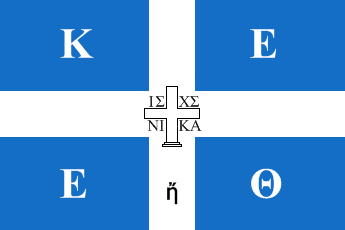
Design of the Flag hoisted at the Arkadi Monastery during the 1866 Cretan Uprising, and preserved by Charikleia Daskalaki (Information about this image)
By the afternoon of the second day, the Turkish heavy artillery had pulverized the outer walls. The defenders killed hundreds more invaders, but the end was clearly near - ammunition was running low and the gate was almost breached. As darkness fell, the Turks launched a massive final assault, pouring through the gate into the inner courtyard, where the rebels fought them hand to hand.
Meanwhile, Giaboudakis was preparing to carry out his plan. He led more than 600 women and children into the monastery's gunpowder storage room, where they said their prayers and waited until hundreds of Turks were swarming over the roof and ramming away at the bolted door. As the door splintered, Giaboudakis put a spark to a gunpowder keg.
The massive explosion killed all the refugees, along with several hundred Turkish soldiers. When the smoke cleared, 864 Cretan men, women and children lay dead, along with 1500 Turks. The Turks took 114 prisoners whom they immediately put to death. Only 3 rebels managed to escape to tell the tale.
News of the slaughter at Arkadi Monastery, with the heavy loss of women, children and clergymen shocked the rest of Europe and won much support for the Cretan rebels' cause. In 1898, with help from Greece and the Great Powers (England, France, Italy and Russia), Crete won its independence and the Turks withdrew from the island, which they had held since 1669.
Then in 1913, the long-fought-for goal was achieved and Crete was united with Greece.
Text and photo from the website of the Rethimnian Association of Melbourne "Arkadi"
Images and text on this page can be reproduced freely as long as the source is referred to as "(by STIGMES, the magazine of Crete)" and linked to http://stigmes.gr



Daskalakis/ bloodstained flag, from the massacre of the Arcadi monastery (1866).
| Ancient Greece
Science, Technology , Medicine , Warfare, , Biographies , Life , Cities/Places/Maps , Arts , Literature , Philosophy ,Olympics, Mythology , History , Images Medieval Greece / Byzantine Empire Science, Technology, Arts, , Warfare , Literature, Biographies, Icons, History Modern Greece Cities, Islands, Regions, Fauna/Flora ,Biographies , History , Warfare, Science/Technology, Literature, Music , Arts , Film/Actors , Sport , Fashion --- |
Retrieved from "http://en.wikipedia.org/"
All text is available under the terms of the GNU Free Documentation License


